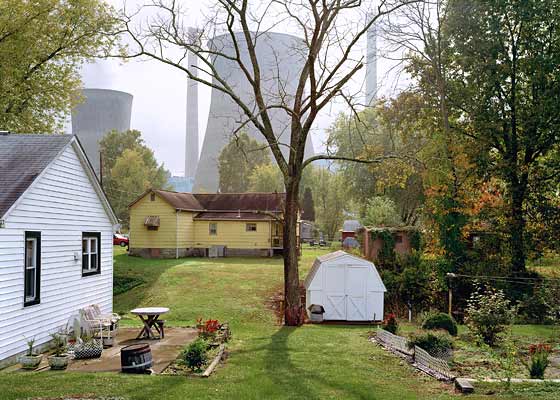
In Mitch Epstein’s Amos Power Plant, Raymond, West Virginia, two nuclear-reactor cooling towers—vast mushroom-like growths—rise above a sweet patch of small-town America. Their overweening scale dwarfs the trim green lawns and houses in the foreground, and their abstract shape and ashen color appear ominous, as if they were designed to draw the garden brightness from the world. (To see them, you must look through the stately branches of a tree.) Epstein’s image is characteristic of “Ecotopia,” a survey of 100 recent photographs, videos, and documentaries made in response to environmental crises now enveloping the planet. In our new century, the works suggest, the pretty pictures no longer tell the truth. The natural world is being raped, diminished, cramped, massacred.
As an exhibition of art, “Ecotopia,” which opened last week at the International Center of Photography, is rarely as interesting as Amos Power Plant. Most of the works (by more than 40 people) billboard one obvious moral or another; together they amount to a photo polemic. As the expression of a gathering social pessimism about the environment, however, “Ecotopia” is telling: Fear of an approaching natural apocalypse, and an attendant hopelessness, are becoming pervasive. In the nineteenth century, Americans regarded nature with hope; the wilderness was a source of both wonder and bounty. As that optimism faded, Americans still appeared confident that they could manage nature, and environmentalists displayed the vigor of fighters for a cause.
Now the feeling grows that a hard accounting is inevitable. Global warming appears irreversible. Certain biological terrors lie beyond the control of science. Nature takes its revenge in the form of fires, mudslides, tsunamis, and, of course, Katrina. In “Ecotopia,” the approaches to the natural world that have traditionally offered a measure of hope, solace, and pleasure are relentlessly shattered, one after another. Is anything left of the sublime? Depictions of nature’s majesty are digitally created or manipulated so that viewers, should they actually thrill to a scene, just feel tricked. A woodland glade conceals, we are told, the remains of a destroyed Palestinian village. Forests lie in ruins. Even the most romantic image in the exhibit—Clifford Ross’s photograph of a mountain lake—is strangely unsettling. He has a camera that depicts near and far with equal precision. And an implacable clarity. There’s no place left to hide.
Nature at its most elemental once inspired soulful awe in artists—nature terribilitá. In this exhibit, we are instead immersed in the foul residue of nature’s power. A corpse lies facedown in the mud. A mattress floats in a tree. Ugly crows plague a gray village. In its wake Katrina leaves behind heaps of candy-colored consumer trash. Sometimes, nature’s power comes filtered (the hip word is mediated) through a diminishing or cheapening lens, such as a tourist video. Environmentalists appear as marginal cranks, admirable but without real power. They engage in existential gestures, such as living in trees to prevent their destruction. The world of animals is much diminished. The fine old tradition of documenting the natural world is parodied in a handsome series of black-and-white photographs by Victor Schrager, who depicts a human hand holding various lovely birds. This hand, we eventually notice, has emerged through a torn backdrop to trap the birds.
In “Ecotopia,” tigers are presented not as masters of the primordial forest but as cute puddy tats playing with beach balls. The extinct dodo is re-created and placed (for a photo op) in its ancient environment. The most beautiful creatures on display are two battling bugs in a film by Catherine Chalmers, who is best known for her project “American Cockroach.” The future, in fact and fancy, appears bleak. Global warming will soon destroy the culture of an ancient Eskimo village. Cruddy development will force the natural world into smaller and smaller corners. Mary Mattingly imagines a strangely beautiful environment in which humans, to survive, have to adapt technology in startling ways—by living, for example, inside clothing that’s a “wearable home.”
Often, a disquieting paradox underlies the best apocalyptic art: a dark internal fire, even an end-of-the-world glee, illuminates the despair. In “Ecotopia,” the art rarely has that kind of energy: It is angry, but also wan, thoughtful, disconsolate, and well behaved. You’ll be relieved to hear, I’m sure, that the catalogue is printed on 100 percent recycled paper.
Ectopia
International Center of Photography. Through January 7.